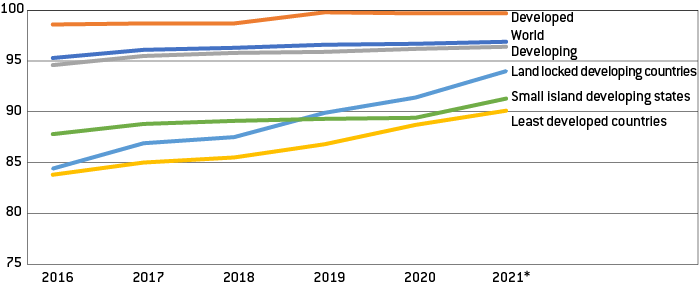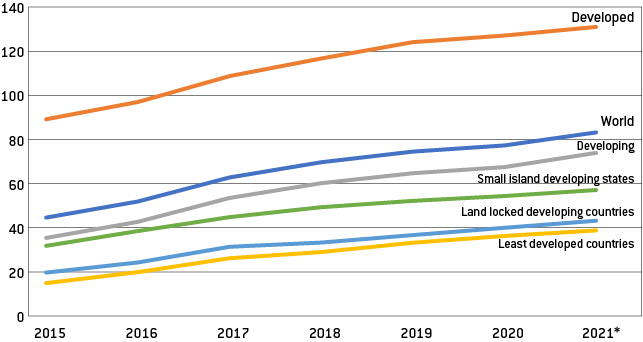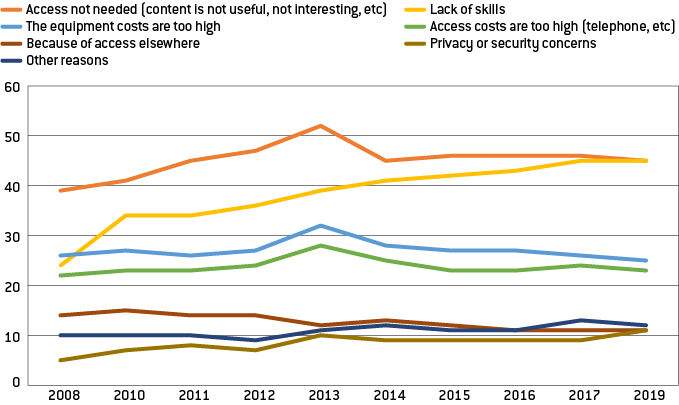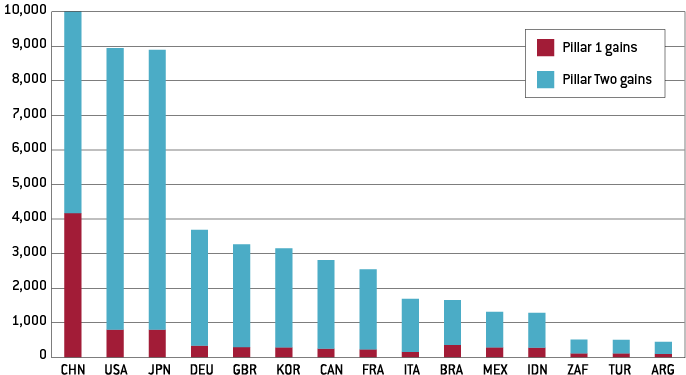Promotion of high capacity broadband to rebuild and recover from the pandemic
High-capacity broadband infrastructure will be a key enabler of a forward-looking recovery after COVID-19.

Executive summary
Promoting high-quality fixed and mobile broadband for all, at an affordable price, is an important enabler of the digital transformation of society and will help close the digital divide. This became clearer than ever during the pandemic, when broadband access was a crucial enabler of remote work, distance learning, telemedicine and e-commerce.
It has always been challenging to provide broadband access to all at an affordable price. The pandemic, global geopolitical tension and Russia’s invasion of Ukraine have exacerbated supply-chain disruptions in ways that make this even more difficult and potentially expensive.
Promotion of broadband deployment, adoption and use are all important for both fixed and mobile broadband; however, different policy levers are needed in each case, on both the supply and demand sides. The market will not always deliver complete solutions. Consequently, there is a role for regulation, targeted industrial policy and public finance. Promotion of competition, combined with prompt and efficient provision of access to resources such as electromagnetic spectrum and access to land and rights of way, can be particularly important.
G20 countries and others now seek a future-proof, sustainable and equitable recovery, meaning new sources of public revenues need to be considered. Broadband can be boosted by judicious use of recovery funds and expected new tax revenues arising from global tax reforms agreed within the Organisation for Economic Co-operation and Development.
An earlier version of this paper was published by the T20 (the think tanks of the G20)
1 Challenge
Widespread availability and use of high-quality broadband have become fundamental to achieving a more prosperous and equitable society. United Nations Sustainable Development Goal 9 (Goal 9 or SDG 9), which seeks to “build resilient infrastructure, promote inclusive and sustainable industrialization, and foster innovation,” explicitly recognises the importance of broadband, primarily through Target 9.c, which sets a goal to “significantly increase access to ICT and strive to provide universal and affordable access to internet in LDCs [least-developed countries] by 2020.” Given the centrality of internet access to modern life, it has become clear that it is unacceptable for anyone to be involuntarily excluded because of the high cost or lack of availability of broadband internet access with acceptable quality parameters.
Broadband contributes to prosperity. Multiple studies have found that an increase in the broadband penetration rate can lead to a rise in GDP (Röller and Waverman, 2001; Czernich et al, 2011; Campbell et al, 2021). As more people gain effective access to the network, the value grows for all users because of network effects.
Broadband promotes innovation, enabling the creation and use of internet-based services; this lifts the overall economy
Broadband also promotes innovation, enabling the creation and use of a wide range of internet-based services. This lifts the overall economy and boosts competitiveness (Marcus et al, 2021). The COVID-19 pandemic demonstrated that broadband access is a crucial enabler for remote work (Marcus et al, 2022), distance learning, telemedicine and e-commerce.
High-capacity broadband infrastructure will be a key enabler of a forward-looking recovery after COVID-19. Both fixed and mobile broadband technologies can be deployed to close the digital divide. Fixed broadband infrastructure is the foundation of this process in many countries, but mobile broadband is an important complement in all countries. In some G20 countries, mobile broadband will be the primary means of serving parts of the national territory for the foreseeable future.
It is important to distinguish between deployment (as characterised by the coverage of fixed and mobile broadband networks), adoption (the share of the public that subscribes or has access to services), and the usage of broadband services.
Adoption and use are dependent on deployment. Many different technologies are used to achieve deployment, including fixed telecommunication networks and mobile networks, cable television networks, fixed wireless networks and satellite networks of various forms. Our primary focus in this paper is on fixed telecommunication and mobile networks because these are by far the most common, though other technologies can also be important, especially in remote or low-density regions.
Unfortunately, even in highly developed countries, the cost of deploying high-speed fixed broadband to the most costly portions of the national territory is typically greater than the price many consumers are willing or able to pay. Population density, topography and availability of existing telecoms or cable television infrastructure are important for determining costs, especially for fixed networks. The economics of deployment tend to be favourable in large cities with good access to global connectivity, but are challenging in mountainous or remote regions, on islands or in land-locked countries far from submarine cables.
Deployment of mobile networks is less problematic than fixed, but Figure 1 clarifies that there are still gaps. Coverage of mobile networks is close to 100 percent in developed countries, somewhat lower in developing countries, but substantially worse in the least-developed countries (LDCs), in land-locked developing countries (LLDCs), and small island developing states (SIDS) (ITU, 2021). In many parts of the world, high oligopoly prices for access to submarine cables, bloated fees for access to cable landing stations and inflated costs for leased lines to access the cable landing stations, can impede internet access or inflate its price. This is a particular concern for land-locked countries (Research ICT Africa, 2016).
It is worth noting, moreover, that not all coverage corresponds to high performance, robustness or reliability. Even so, country averages for basic mobile coverage exceed 90 percent in most countries (but are far worse for fixed coverage).
Figure 1: Percent of population covered by a mobile cellular network

Source: Bruegel based on ITU (2021). Note: * data for 2021 is estimated because the year was not complete when the data was collected.
The situation is much worse for adoption[1] than for deployment. Only about 40 percent of inhabitants of land-locked countries or LDCs have a mobile subscription (Figure 2)[2].
Figure 2: Active mobile broadband subscriptions per 100 inhabitants

Source: Bruegel based on ITU (2021).
Once broadband service has been taken up, there is still no assurance that it will be used efficiently, effectively or securely. Survey results from multiple countries demonstrate that lack of skills, together with a lack of perceived value of internet services (which likely reflects in large part a lack of skills), is the most severe impediment to adoption for many users (for the European Union, see Figure 3 in section 2.2).
In nearly all countries, public policy intervention is required to achieve full coverage and widespread adoption together with extensive use.
2 Proposal
Different countries face different challenges in achieving broadband deployment, adoption and use; however, they also bring different strengths to the task. Among the relevant ways in which countries differ are: (1) disposable income; (2) the degree of digital competence on the part of the public; (3) population density and dispersion; (4) physical topography, including distance if relevant to submarine cables; (5) existing coverage of fixed, mobile and cable networks; and (6) physical characteristics of deployed networks (for instance, the length of copper sub-loops from the street cabinet to the residence).
The Organisation for Economic Co-operation and Development’s Recommendation on Broadband Connectivity (OECD, 2012), and studies that supported its revision in 2021 (Marcus et al, 2021; Fanfalone, 2022) reflected these considerations. However, all of this must now be understood in a global context profoundly altered by the COVID-19 pandemic and Russia’s invasion of Ukraine.
The pandemic made clear the value of broadband internet access as an enabler for e-commerce and working from home
The pandemic has made clear the value of broadband internet access as an enabler for e-commerce, working from home (Marcus et al, 2022) and a wide range of additional business-to-consumer (B2C), business-to-business (B2B) and e-government services. The pandemic has also disrupted global value chains.
Russia’s invasion of Ukraine, meanwhile, has contributed to the decoupling of global value chains for technology-based goods (Grzegorczyk et al, 2022) and services (Marcus et al, 2022), including telecommunication equipment and other ICTs. This exacerbates stresses on global value chains that were already present because of strategic competition between the United States and China, and further complicates the global deployment of broadband internet access (see section 2.3.2).
Public policy responses need to reflect the different challenges faced by different countries. Deployment challenges must mainly be addressed using supply-side interventions. A well-tuned regulatory policy can greatly promote broadband deployment on the supply side (see section 2.1). Adoption and usage challenges must mainly be addressed using demand-side interventions (section 2.2), focusing on education and training as an ongoing lifelong learning activity. Public and private financing of broadband infrastructure are a different form of supply-side intervention (which we discuss in detail in section 2.3).
Proper institutional design is important for both supply- and demand-side measures. No public policy intervention strategy will likely be effective unless the government draws a clear organisational distinction between industrial policy and regulation. Industrial policy should be administered by the government, typically by a ministry, and should be subject to political accountability to voters. Regulation, however, seeks to impartially administer detailed policy initially set at political level. Regulation must be insulated from political pressure to ensure that rules are administered fairly and impartially (OECD, 2011). The ultimate accountability of the regulator is not to the voters but to the courts.
At the industrial policy level, formulating a national strategic plan for fixed and mobile broadband deployment and adoption can play a positive role in achieving good outcomes (Marcus et al, 2021, pp 36-37).
The maintenance of appropriate and internationally comparable statistics on broadband deployment, adoption and use is crucial (Marcus et al, 2021, pp 38-39). Coherent policy must rest on a clear understanding of where the gaps are and where progress is (or is not) being made. Broadband coverage statistics can be particularly challenging because of imprecise definitions and difficulties in assessing the degree to which coverage overlaps between distinct networks.
Reliable periodic public surveys can also help determine the number of people per 100 inhabitants who do not have access to fixed or mobile broadband, and the reasons for this.
Recommendation 1: Ensure the collection of reliable statistics on network deployment, adoption and usage, conducting surveys as appropriate.
2.1 Supply-side regulatory and policy measures
Reliance on market mechanisms to ensure broadband deployment generally promotes (in the absence of market distortions) competition, innovation, interoperability and consumer choice. However, there are few countries (if any) where relying solely on market mechanisms will result in full coverage for all consumers at reasonable prices. As already noted, deploying high-speed fixed broadband to the most expensive portions of the national territory typically costs more than many consumers are willing or able to pay. There may also be gaps in mobile coverage. Consequently, there is usually a role for public policy to play on the supply side. Public policy interventions must be carefully managed to avoid introducing economic distortions.
Problematic geographic coverage gaps are more likely in regions that do not already have good fixed network coverage for building on, or in regions that have low population density, mountainous regions, islands or low-income land-locked countries.
Regulatory policy measures can help close the deployment gap. There can also be a role for targeted public subsidies to ensure full deployment and full adoption by the poor and the disadvantaged (see section 2.3).
For fixed networks, typical regulatory policy interventions include promotion of competition (section 2.1.1), implementation of alternative ownership or operation structures (section 2.1.2) and measures to reduce deployment costs, thus shifting the balance between cost and revenue (sections 2.1.2 and 2.1.3). For mobile networks, prompt spectrum assignment is important, as are various forms of infrastructure sharing (section 2.1.4).
All of these are best implemented in a context of technological neutrality where the government does not seek to promote needlessly one specific technology over another. Cable television, a high performance infrastructure that is ignored in much of the literature on broadband network deployment, is a case in point. Cable is the majority broadband provider in the United States and Canada, and provides full coverage in the Netherlands, Belgium and Malta. Cable coverage in large metropolitan areas in India is extensive. Cable plays a lesser role in the United Kingdom, a minor role in Japan and France, and none in Italy and Greece, which is perhaps a part of why it is often overlooked. Public policy in many countries treats cable very differently from traditional telecommunications services, even though it is often used to provide services that function as a perfect substitute for traditional telecommunications. Where cable is present, it needs to be part of any regulatory analysis.
2.1.1 Promotion of competition
Competition can occur within a technology, such as fixed telecommunications networks, or between two technologies that can be substituted for one another, such as fixed telecommunication networks and cable television networks, and fixed wireless access and satellite communications. Similar considerations apply to mobile networks.
For fixed networks, it is not economically viable for two or more undertakings to lay cables to the same house in low-density areas of most countries. Some countries have both extensive fixed telecommunications and cable television infrastructure, but this is the exception rather than the rule. The ‘last mile’ to the home is a competitive bottleneck in most countries. Where it is impractical to introduce facilities-based competition, regulation typically obliges the firm that controls the bottleneck last mile facility to make it available to competitors at cost-based prices (eg via unbundling). At a deeper level, regulated access to underground ducts and other passive infrastructure can play an important role. Building wiring within multiple dwelling units can also represent a bottleneck facility amenable to regulatory measures. Approaches such as these are well developed in many countries, especially in Europe, but the regulation is burdensome for firms and may consequently slow broadband deployment. Constant attention is needed to tune regulation to balance these conflicting needs (European Commission, 2021b).
For mobile networks, policymakers generally seek to ensure enough network operators are present in the market. If entry by multiple mobile network operators (MNOs) is impractical, this need is sometimes addressed by introducing rules to enable mobile virtual network operators (MVNOs) to enter the market.
Recommendation 2: Implement procompetitive technology-neutral measures such as unbundling if appropriate, but strike a balance with deployment incentives.
2.1.2 Novel ownership or operational models
Novel ownership or operational models sometimes seek to solve these competition problems in different ways (Marcus et al, 2021, pp 19-22). Notable among these are: (1) ownership and/or operation by the government; (2) structural or functional separation of the incumbent network operator; (3) co-investment models, primarily for the fixed network; and (4) mobile network infrastructure sharing.
Government ownership sometimes works well, notably in Sweden. However, it can lead to economic distortions because the government’s incentives are inherently conflicted and because government investment risks crowding out potential private investment. State-aid protections can prevent this.
Structural or functional separation seeks to solve the tension between competition and investment differently by removing the incentive the firm with the last mile bottleneck facility has to favour its own retail activities over those of competitors.
Co-investment is a newer approach through which all interested firms invest in the bottleneck facility and control it jointly. Infrastructure sharing (for instance, masts used by mobile base stations) is another attempt to solve the tension between competition and investment in broadband deployment.
Many of these potential measures bring benefits but also reduce the effective number of fully independent competitors in a geographic region. Consequently, regulatory authorities or competition authorities should reflect carefully on likely competitive effects before authorising such schemes.
Recommendation 3: Be open to proposals from market players and municipalities to engage in creative ownership models, such as municipal ownership, wholesale-only models or infrastructure sharing and/or co-investment, but take care not to impede competition.
2.1.3 Reducing deployment costs
Another way to try to drive down the cost of broadband deployment is to provide cost-effective access to scarce resources that are essential to its deployment (Marcus et al, 2017). For fixed networks, the cost of civil works (eg trenching) is often crucial. Access to land and rights of way can likewise be critical. Consequently, there can be merit in enabling broadband providers to use unrelated infrastructure (electric utility poles, sewers, water) under fair terms and conditions.
Even though determining the appropriate level of compensation for access to infrastructure is well established in regulatory practice, it tends to be time-consuming, labour-intensive and contentious. The anticipated benefits should therefore be weighed against the administrative costs. Moreover, if compensation is set too low, the firm that originally deployed the infrastructure may choose to deploy less in the future.
Recommendation 4: Consider accelerating network infrastructure deployment by providing regulated, cost-oriented access to ducts, poles and other civil engineering infrastructure used by other telecom operators or other utilities.
Simplifying and accelerating the granting of permits is a crucial, complex and often overlooked element of this process. Permitting broadband providers to run aerial fibre could also be considered since it implies lower capital expenditure. However, the use of aerial fibre typically leads to higher operating costs arising from its exposure to bad weather and other hazards.
The logic of simplifying the permitting process is clear, but experience in the EU and elsewhere shows doing it can be challenging. First, responsibility for issuing permits for crossing public rights of way is highly decentralised in most countries, and also fragmented among multiple agencies; any new law would have to override numerous existing laws and rules. Second, while the public welcomes good broadband access, public resistance to specific deployments is common – the not in my back yard (NIMBY) phenomenon. Third, any rules would need to take into account legitimate concerns such as historic preservation.
Recommendation 5: Ensure that permitting processes are prompt, effective and efficient.
In some countries, access to cable landing stations can also be a significant impediment to network deployment (Research ICT Africa, 2016). Cable landing stations can be a different kind of bottleneck facility. Some countries impose high, non-cost-related charges to access and use cable landing stations. In others, network operators may charge high fees for high-capacity circuits or circuit equivalents to reach the cable landing station, thus imposing a particular burden on low-income land-locked countries. There is no apparent justification for taxing cable landing stations. Given the enormous societal value of modern telecommunications, governments should refrain from imposing taxes on cable landing stations, and should prevent network operators from imposing excessive, non-cost-related charges on circuits and equivalents used to access cable landing stations.
Recommendation 6: Avoid placing taxes or other unnecessary expenses on access to landing stations for submarine cables.
2.1.4 Enabling mobile network deployment
Additional factors apply to the deployment of mobile broadband. National regulatory bodies should assign suitable radio spectrum for mobile broadband in a fair, efficient and timely fashion. Delay in spectrum assignment can represent a substantial negative impact on societal welfare (Hazlett and Muñoz, 2009; Marcus et al, 2017, pp 364-366).
Recommendation 7: Ensure radio spectrum assignments for mobile services are carried out promptly, effectively, efficiently and fairly.
Policymakers sould also resist the temptation to jack up spectrum auction price artificially as a form of taxation. This tends to slow deployment and raise mobile broadband prices, impacting consumer welfare (Marcus et al, 2017, pp 367-368). The goal of spectrum auctions is to ensure allocative efficiency; the revenue raised by the government is a convenient by-product (Coase, 1959) but should not be exploited to the detriment of societal welfare.
Recommendation 8: Resist the temptation to use the spectrum assignment process to maximise government revenue.
Mobile broadband deployment, especially with the expected move to small cells in densely settled areas under 5G, depends heavily on the same permitting and right-of-way access considerations already identified for fixed networks. Overcoming public resistance, to the extent that it is not objectively justified, is particularly important. NIMBY considerations that delayed deployment of large cellular masts in the past are far less relevant for tiny microcells that are barely visible on street furniture (eg at bus stops) or on the sides of buildings.
Recommendation 9: Consider simplified permitting processes for small mobile base stations (eg for 5G in dense metropolitan regions).
There are public concerns about the health effects of mobile services, but harms have not been demonstrated (and there is no particular reason to expect more problems with 5G services than with previous generations). However, the evidence is not conclusive, and perhaps never will be. If harms were common, they should have been obvious long ago in epidemiological cohort studies. Policymakers should not overreact to public fears that are not based on objective science (Pujol et al, 2019, pp 103-123; Marcus et al, 2021, p 27).
Recommendation 10: Measures to deal with possible health effects of mobile services should not go substantially beyond what is called for based on scientific and medical advice.
2.2 Demand-side measures
In many countries, the greatest challenge in achieving broadband adoption and usage (as distinct from deployment) is the lack of training or interest on the part of consumers. This is well documented for the EU (Figure 3) and the United States (Marcus et al, 2021, p 57). Particularly striking is the increase over time in the importance of lack of training and, to a lesser degree, the increase in the relative importance of the sense, among people without internet at home, that access is not needed (because the content is not helpful or not interesting, for example). These factors combine with growing concerns over privacy and security.
Shortfalls in training and consumer interest cannot be solved solely by ‘pushing’ with supply but must also be ‘pulled’ using demand-side measures.
Figure 3: Reasons given for not having internet access at home by households without internet access, European Union (2008 - 2019)

Source: Bruegel based on Eurostat (ISOC_PIBI_RNI last updated 30 March 2022)[3].
Once broadband service is sufficiently widely available, demand-side measures can be considerably more effective than supply-side measures in promoting take-up (Belloc et al, 2011; Parcu, 2011; Marcus et al, 2013). The measures assessed by Parcu (2011) were: (1) demand aggregation policies; (2) direct demand subsidies (discounts on the purchase of equipment or broadband services, direct subsidies or tax breaks); (3) coordinating government demand (through procurement policy or by promoting e-government services); (4) incentives to private demand for the poor and the elderly; and (5) incentives to business demand.
As with any subsidy, it is necessary to first assess costs and benefits. What is the demand elasticity relative to the size of the subsidy? Is the investment warranted? When it comes to digital divide issues, social benefits must be evaluated, not just economic benefits.
Recommendation 11: Consider direct demand subsidies (discounts on purchasing equipment or broadband services, direct subsidies or tax breaks), together with incentives to private demand for the poor, the elderly and other disadvantaged groups. Doing so serves both to promote broadband adoption and to reduce ‘digital divides’.
Recommendation 12: Consider demand-side measures such as aggregation of demand, procurement policies that foster broadband adoption, or promotion of e-government services.
Survey data (Figure 3) also suggests a need (at least in Europe) for better and more internet-specific education and training and for steady improvements in the cybersecurity and privacy offered by online services.
Training has a significant role to play here. The COVID-19 pandemic has driven a dramatic acceleration of working from home. Many workers have needed to familiarise themselves not only with traditional internet skills but also with videoconferencing tools including Zoom and Microsoft Teams (Marcus et al, 2022). The ability to shop online likewise took on far greater importance during COVID-19 than in pre-pandemic days.
Increasing digitalisation, and especially the increasing use of artificial intelligence and machine learning, are transforming the workplace profoundly in most countries. Most experts think that earlier fears that vast numbers of jobs would suddenly disappear were overblown (Arntz, 2017). However, a great many jobs will be transformed radically in the next decade or two[4]. This is another factor suggesting the need for more education and training and also for a different kind of education and training (Stephany, 2022). It is no longer appropriate to think of education solely as something one undertakes before one begins a career. Instead, a shift to lifelong learning is needed urgently, but has been slow in coming because of institutional rigidities in most countries (Petropoulos et al, 2019).
Recommendation 13: Education and training focusing on digital skills are fundamental to the modernisation of society, adaptation to the changing workplace, and the avoidance of digital divides. There is an urgent need to move beyond traditional models of education and training, towards a focus on lifelong learning.
There is also good reason to think that lack of trust in the internet can serve to depress adoption and usage (see for instance Figure 3). Measures to strengthen cybersecurity, robustness and privacy for services on the internet can help restore trust and thus, in principle, greater take-up of broadband internet access.
Recommendation 14: Ensure broadband internet services are secure, reliable, robust and respectful of personal privacy.
2.3 Financing deployment of broadband infrastructure
2.3.1 Investment needs
The costs of rolling out broadband, and therefore the investment needs, are influenced strongly by the quality of service the network is expected to deliver, the degree of coverage desired (coverage of a small percentage of the national territory that is hard to reach with less powerful broadband can result in significant savings), and by numerous modelling assumptions. A few countries already have (or are well on their way to having) full territorial coverage of highly capable broadband. Japan, Korea and the Netherlands are good examples. For most others, significant further investment is needed.
The European Investment Bank has estimated (EIB, 2018) the magnitude of the funding gap to achieve the European Union’s fixed and mobile broadband objectives, as expressed in the Digital Agenda for Europe (European Commission, 2010) and the European Gigabit Strategy (EGS) (European Commission, 2016). The EGS establishes strategic objectives for 2020 of (1) achieving availability of 5G connectivity as a fully-fledged commercial service in at least one major city in each EU country; and for 2025 of achieving (2) “Gigabit connectivity for all main socio-economic drivers such as schools, transport hubs and main providers of public services as well as digitally intensive enterprises”; (3) uninterrupted 5G coverage for all urban areas and all major terrestrial transport paths; and (4) providing access to internet connectivity offering a downlink of at least 100 Mbps, upgradable to gigabit speed, to all households in the EU, rural or urban. The EIB found that a total investment of $453 billion would be required by 2025 under the most likely assumptions. The EIB further estimated that $153 billion (33 percent) of that funding could be expected to come from private investments, and that the remaining $300 billion represented an investment gap that would have to be addressed by public policy interventions (Marcus et al, 2021).
A number of caveats must be considered regarding these numbers. First, they reflect the state of play as of 2018, prior to the pandemic. Second, and relatedly, investments subsequently made with EU, member state, regional or local funds are not reflected. Third, the EU goals as expressed in the Digital Compass (European Commission, 2021a) that all households “be covered by a Gigabit network, with all populated areas covered by 5G” are not reflected in these estimates.
For the United States, the US Federal Communication Commission’s Paul de Sa (2016) estimated the cost of rolling out service at 25 Mbps download speed and 3 Mbps upload speed to approximately 14 percent of the 160 million US residential and small-and-medium business locations that did not already have correspondingly fast fibre-to-the-premise (FTTP) or cable service, would be about $80 billion[5] for full coverage, but only about $40 billion to achieve 98 percent coverage (once again because the cost per household for the last 2 percent of locations is very high).
A clear implication of this analysis (together with similar results for other countries) is that in many countries, achieving good coverage to the most remote or hardest-to-reach 1 percent or 2 percent of the population triggers very high unit costs. Alternative deployment technologies (fixed wireless access, mobile, or satellite) should be considered.
2.3.2 A changed world order poses impediments to deployment
Before discussing the possibilities of funding the global transition to modern broadband based on fixed fibre assets and 5G mobile networks, it is necessary to discuss how the international world order has changed and the implications for broadband deployment and adoption. With the return of war to Europe and with growing US-China rivalry, confidence in global value chains can no longer be assured. In relation to Russia, high-tech decoupling is already underway (Marcus et al, 2022; Grzegorczyk et al, 2022).
Global value chains were already disrupted before Russia invaded Ukraine. The pandemic created significant disruption because of shortages of shipping containers and labour. Trade tensions between China and the United States simmered before 2017, but exploded with the election of Donald Trump, and also also escalated between the US and the EU during the Trump presidency.
Trade restrictions on fixed and mobile technologies are likely to pose a growing threat to broadband deployment. They will often imply that it is impractical to purchase equipment and services from the best price/performance vendor, meaning higher deployment costs.
Trade restrictions on fixed and mobile technologies are likely to pose a growing threat to broadband deployment
Global communications system interoperability might be at risk. Standards for 4G and 5G converged to enable full global interoperability, but this was not always the case. Standards for 2G were hugely fragmented between the EU, Japan and the US (and were even fragmented within the US). This fragmentation persisted with 3G.
Standards work for 6G, the next generation of mobile services (expected to begin deployment circa 2030), seem to be on track to produce fully interoperable standards, at least at the airlink level. Whether this apparent unity can be maintained in the face of growing geopolitical stress remains to be seen. If interoperability cannot be maintained, it might no longer be possible to use the same mobile phone or tablet when travelling from one country to another, similar to the fragmentation experienced under 2G and 3G mobile services.
Concerns in the US have mainly centred on the concern that China could exert undue influence over the standards development process, though this does not appear to be the case today. Bruer and Brake (2021) found that “participation by Chinese actors is certainly increasing, but the outcomes of the process generally appear to be fair, with notable exceptions being relatively rare.” Neaher et al (2021) found that “Chinese representation within standards bodies is far from reaching a disproportionate level, especially in comparison to the country’s economic weight.”
Increasing reliance on a wide range of de-facto trade sanctions (Gibson Dunn, 2021; US Department of the Treasury, 2021) has already resulted in a significant degree of decoupling – not only classic restrictions on exports and imports, but also secondary sanctions, restrictions on foreign direct investment and restrictions on visas for experts from other countries.
Trade restrictions can be associated with significant costs, including (1) the aforementioned loss of interoperability; (2) relatedly, the loss of the ability to seamlessly roam; (3) loss of manufacturing economies of scale; (4) unrealised gains in trade where components could have been manufactured more efficiently in one country than in another; and (5) less-robust competition for electronic communications equipment and services, resulting in higher end-user prices and less choice.
Recommendation 15: While trade restrictions may be unavoidable in a world subject to increasing geopolitical stress, policymakers should evaluate the economic, operational, social and practical costs of such restrictions for their country and other countries.
2.3.3 Private investment
The promotion of domestic private investment is desirable, but it is mainly up to domestic investors, not to policymakers. The primary role of policymakers is to ensure that public policy interventions do not become so intrusive that they depress private investment.
For foreign investment, however, the increasingly polarised world poses real challenges. Moreover, telecommunications has always been a special case. A country’s core telecommunications network has traditionally been viewed as a strategic asset. Plans by foreign entities to invest in these networks have often led to intensive reviews by national security authorities (such as in the United States and Italy in the past).
In an era of increasing political tension, especially between the US and China, any significant proposed foreign investment in critical communications network firms or other sensitive digital infrastructure will unavoidably require intensive, careful review by national authorities. How durable is the friendly, peaceful relationship with the country of the firm that wishes to invest? If there is a significant risk of future conflict with the investor’s country (or perhaps with the government of a firm that might acquire the firm that wishes to invest), the investment may be ill-advised. No country will want to be vulnerable to foreign pressure over such a critical asset.
Recommendation 16: Because of the critical nature of electronic communications and the increasingly tense geopolitical situation, weigh carefully the risk of future conflict or stress with the country concerned before permitting FDI into core electronic communications assets.
For similar reasons, the choice of equipment and software for key telecommunications assets has become much more delicate. If a dispute should arise with another country, no country will want to be vulnerable to covert foreign surveillance from within its core telecommunications networks. An unfortunate corollary of these considerations is that the cost of building and operating broadband networks is likely to increase because of geopolitical tensions, since it may no longer be safe to purchase gear from the best-value supplier.
Recommendation 17: Weigh carefully the risk of possible future conflict or stress with the supplier country when selecting equipment that will play a key role in core telecommunication networks.
2.3.4 Targeted public subsidy
There are two main justifications and forms of public subsidy for broadband internet access: (1) subsidies to individuals to make the service affordable for those who are poor, disabled or otherwise disadvantaged; and (2) targeted subsidies to network operators to compensate for the difference between what consumers are willing to pay, and the short-run marginal cost of the services (below which the service cannot be profitable).
Affordability subsidies are an important means of mitigating digital divides within a country (see section 2.2). The goal is to ensure that anyone who wants broadband internet access can afford it, but typically not to oblige people to subscribe. The mechanisms used to manage these subsidies and to fund them can be very different in different countries. In some, they are treated as an element of social protection, while in others, they are administered under telecommunications regulation as an element of universal service.
Recommendation 18: Most countries require some public subsidy for broadband, either to ensure that broadband is affordable for all consumers or to ensure it reaches all (inhabited) parts of the national territory.
Targeted aid to network operators is a public subsidy that raises many state aid concerns. First, a public subsidy can crowd out private investment that otherwise might have been expected; consequently, deployment should be funded only in regions that otherwise would lag in broadband deployment. Second, subsidies can easily lead to economic distortions, making it is important to implement the support in such a way that avoids needless distortion. This implies the need for rules that typically require periodic review and refinement (European Commission, 2021b).
Recommendation 19: When public subsidy is provided for broadband, state aid checks must be done. Aid should not be provided for areas that could be funded by private investment. Economic distortions should be avoided as much as possible.
Mechanism aside, a more immediate question might be what is the most appropriate source of the funds, particularly considering that they are likely to be substantial.
Some countries have already achieved substantially complete fixed and mobile broadband network deployment, while others have plans and can generate sufficient funds through available domestic revenues. Our focus in the following sections is on tools for countries that struggle to finance broadband deployment.
2.3.5 Judicious use of pandemic recovery funds
Many countries are implementing substantial and generous programmes of grants and loans to finance recovery from the COVID-19 pandemic. It is widely recognised that these funds should not be used solely to rebuild what was there before, with the inefficiencies and problems already embedded in the old infrastructure, but rather to modernise society as a whole (Darvas et al, 2021). It can therefore be appropriate to tap recovery funds to promote digitalisation, including broadband deployment. The US and the EU provide case studies of how this has already been implemented.
In the US, these considerations are reflected in the Infrastructure Investment and Jobs Act. The primary tool is current $42.45 billion in funding for broadband deployment grants delegated to the states for roughly the period 2022-2026[6]. As a prelude to the use of these grants, the Infrastructure Investment and Jobs Act obliges the US Federal Communications Commission to prepare new maps of broadband deployment, and gives the FCC new powers to do so. The maps are to identify unserved and underserved areas, with an unserved area either an area that “has no access to broadband service” or “lacks access to reliable broadband service offered with a speed of not less than 25 megabits per second for downloads; and 3 megabits per second for uploads; and a latency sufficient to support real-time interactive applications.” The definition of an underserved area is nearly the same, but with 100 Mbps download and 20 Mbps upload speed.
In the EU, digitalisation is one of the main priorities of the Recovery and Resilience Facility (RRF), the largest component of NextGenerationEU (NGEU), the European Union’s instrument for recovery from the coronavirus pandemic. The RRF provides up to €338 billion in grants and €385.8 billion (in 2018 euros) in loans on favourable terms (though less than half of the money available for loans had been applied for at time of writing). EU countries are required to spend at least 20 percent of their RRF funds on digitalisation or dealing with its impacts, and 37 percent on sustainability (the spending period is 2021-2026). National implementation plans for the grants call for 26 percent of these expenditures to be used for digitalisation and 40 percent for sustainability, thus exceeding the RRF requirements (European Commission, 2021c). Broadband featured prominently in the goals of the RRF, but only 9 percent (€10.7 billion) of funds requested under the grant facility are, in fact, being spent on connectivity (Darvas et al, 2021). There is thus an opportunity to do more.
Recommendation 20: Many countries provide public funding to help recovery from the COVID‑19 pandemic. Modernisation of society should be among the goals when countries decide how best to apply these funds. Public subsidy for broadband can thus be an appropriate use of pandemic recovery funds.
2.3.6 Possible earmarking of new corporate taxation revenues
There have been calls, mainly in Europe, for the largest online platform providers, based mainly in the US and China, to make additional contributions to fund the deployment and operation of broadband networks. An open letter from the CEOs of 13 major European network operator firms called for big tech platforms to “contribute fairly to network costs” (ETNO, 2021).
Many of the same firms should also start to make digital tax payments to European and other governments in relation to the OECD Base Erosion and Profit Sharing (BEPS) project. This recognises that current rules make it easy for firms, especially high-tech firms with high-value intangible assets, to pay taxes in the jurisdictions of their headquarters, which might be low or zero tax jurisdictions. Current tax arrangements do not reflect digitalisation and globalisation in which companies can sell online and generate large profits but pay little tax where those profits are made (OECD/G20, 2021). Many of these firms benefit from a global market that is well-served by fast and reliable broadband access.
The rules agreed internationally in late 2021 by the OECD and G20, some 140 countries in all, would (1) redistribute corporate taxing rights so that some corporate tax is paid in jurisdictions in which profits are earned (referred to as Pillar One), and (2) the largest companies pay a minimum corporate effective tax rate of 15 percent (Pillar Two) (OECD/G20, 2021). The minimum corporate tax rate of 15 percent can be expected to reduce the incentive for technology firms, including the largest digital platforms, to park assets in low-tax jurisdictions.
These funds will be general taxation revenue and not earmarked to broadband deployment. But they will, for the most part, be paid by the same firms that allegedly do not contribute their ‘fair share’ to broadband deployment worldwide, and it is clear that the revenues could be large enough to potentially serve, if desired, as an important spur to broadband deployment.
The OECD has estimated the global impact on national corporate tax revenues to be substantial: “Under Pillar One, taxing rights on more than $125 billion of profit are expected to be reallocated to market jurisdictions each year.” The global minimum tax rate of 15 percent could generate “around $150 billion in new tax revenues globally per year” (OECD/G20, 2021).
The OECD has estimated expected per-country gains in corporate tax revenues from Pillars One and Two. Unfortunately, this analysis is not public, but some rough extrapolations from the published report can be made (OECD/G20, 2021; Figure 4).
The gains from the corporate tax reforms are not limited to developed economies. Among developed G20 economies, the US, Japan, Australia, the UK, South Korea and Canada would be big winners based on our conservative estimate of annual gains in corporate tax revenue; however, China is by far the biggest winner overall. The gains of Brazil and Mexico are comparable to those of countries like Spain.
Figure 4: Gains in annual corporate tax revenue ($ millions/year), selected G20 countries

Source: Bruegel based on OECD/G20 (2020). Note: the total value for China is $19.2 billion.
Recommendation 21: Consider earmarking (in one way or another) a portion of the new corporate taxation revenues arising from the OECD/G20 BEPS reforms to subsidise broadband deployment and adoption.
2.3.7 Loans from multilateral development banks and other sources
For many countries, the most cost-effective means of financing broadband development will be a loan from one of the multilateral development banks (MDBs), such as the World Bank, the EIB or the Asian Development Bank (ADB). Because an MDB loan spreads risk, interest rates are generally favourable compared to what a developing country could obtain on its own.
Within the EU, for instance, the previously mentioned RRF may represent an attractive means of financing for some EU countries. As previously noted, EU countries have applied already for all of the grant money; however, less than half of the €385.8 billion available under the RRF loan facility has been touched so far – only €166.0 billion, three quarters of which was requested by Italy (Darvas et al, 2022). It is possible under the RRF Regulation to apply for an RRF loan until August 2023. This is a large sum of money relative to EU broadband investment needs. But it will not be attractive to every EU country. Germany, for example, can probably obtain more favourable terms on its own.
Recommendation 22: Consider using a loan to accelerate the availability of funds for public subsidies for broadband deployment. This might be provided by (for instance) one of the Multilateral Development Banks, or might be obtained by tapping pandemic recovery funds.
3 Conclusions
Broadband needs have become even more critical in light of recent shocks to the global economy, including the COVID-19 pandemic and Russia’s invasion of Ukraine. Together with US-China strategic competition, these strains risk technological and market decoupling that complicates the achievement of global broadband deployment and adoption. They also put at risk the achievement of United Nations Sustainable Development Goal 9 (SDG 9), which seeks to “build resilient infrastructure, promote inclusive and sustainable industrialization, and foster innovation”.
This scenario calls for supply- and demand-side measures to ensure that broadband is deployed, adopted and used.
Our key recommendations to policymakers are:
- Supply-side: Boost deployment of broadband infrastructure and services by making the prerequisites available and driving down the cost to providers.
- Procompetitive tools;
- Prompt and efficient access to spectrum and to land and rights of way;
- Sharing of (passive) infrastructure, including suitable non-telecommunications infrastructure.
- Demand side: Boost adoption and use of broadband services by ensuring that internet is available, affordable and usable.
- Direct subsidy;
- Demand aggregation;
- Education and training;
- Privacy and security.
- Funding: Pursue new, innovative sources of finance to support public funding to selectively accelerate deployment where needed.
References
Arntz, M.T. (2017) ‘Revisiting the Risk of Automation’, Economics Letters 159: 157-160
Belloc, F., A. Nicita and M. Rossi (2011) ‘The Nature, Timing and Impact of Broadband Policies: a Panel Analysis of 30 OECD Countries’, mimeo, University of Siena
Benedek, W., V. Bílková and M. Sassòli (2022) Report on Violations of International Humanitarian and Human Rights Law, War Crimes and Crimes against Humanity Committed in Ukraine since 24 February 2022, Organization for Security and Co-operation in Europe: Office for Democratic Institutions and Human Rights
Bruer, A. and D. Brake (2021) Mapping the International 5G Standards Landscape and How It Impacts U.S. Strategy and Policy, Information Technology and Innovation Foundation
Campbell, S., J.R. Castro and D. Wessel (2021) ‘The benefits and costs of broadband expansion’, Up Front 2021/08, Brookings
Coase, R. (1959) The Federal Communications Commission, University of Chicago Press
Czernich, N., O. Falck, T. Kretschmer and L. Woessmann (2011) ‘Broadband Infrastructure and Economic Growth’, The Economic Journal 121(552): 505-532
Darvas, Z., M. Domínguez-Jiménez, A.I. Devins, M. Grzegorczyk, L. Guetta-Jeanrenaud, S. Hendry, M. Hoffmann, K. Lenaerts, A. Tzaras, V. Vorsatz and P. Weil (2022) ‘European Union countries’ recovery and resilience plans’, Bruegel Dataset, available at https://www.bruegel.org/dataset/european-union-countries-recovery-and-resilience-plans
Darvas, Z., J. Scott and A. Tzaras (2021) ‘Will European Union recovery spending be enough to fill digital investment gaps?’ Bruegel Blog 2021/07, Bruegel
de Sa, P. (2016) Improving the Nation’s Digital Infrastructure, FCC Office of Strategic Planning
European Commission (2010) ‘A Digital Agenda for Europe’, available at https://www.europarl.europa.eu/factsheets/en/sheet/64/digital-agenda-for-europe#:~:text=The%20digital%20Europe%20programme%2C%20a,a%20wide%20use%20of%20digital
European Commission (2016) ‘Connectivity for a Competitive Digital Single Market - Towards a European Gigabit Society’, COM(2016)587, available at https://digital-strategy.ec.europa.eu/en/library/communication-connectivity-competitive-digital-single-market-towards-european-gigabit-society
European Commission (2021a) ‘2030 Digital Compass: the European way for the Digital Decade’, COM(2021) 118 final, available at https://eufordigital.eu/library/2030-digital-compass-the-european-way-for-the-digital-decade/
European Commission (2021b) Study on regulatory incentives for the deployment of very high capacity networks in the context of the revision of the Commission’s access recommendations: final report, Publications Office of the European Union, available at
https://data.europa.eu/doi/10.2759/33048
European Commission (2021c) ‘Recovery and Resilience Facility’, available at https://ec.europa.eu/info/business-economy-euro/recovery-coronavirus/recovery-and-resilience-facility_en#:~:text=It%20makes%20available%20%E2%82%AC723.8,spurring%20growth%20in%20the%20process
European Investment Bank (2018) A study on the deployment costs of the EU strategy on Connectivity for a European Gigabit Society
European Telecommunications Network Operators’ Association (2021) ‘Joint CEO Statement: Europe needs to translate its digital ambitions into concrete actions’, available at https://etno.eu/news/all-news/717-ceo-statement-2021.html
Fanfalone, A.G. (2022) Emerging Trends in Communication Market Competition, Organisation for Economic Co-operation and Development
FCC (2010a) Connecting America: The National Broadband Plan, Federal Communication Commission, available at https://transition.fcc.gov/national-broadband-plan/national-broadband-plan.pdf
FCC (2010b) ‘The Broadband Availability Gap’, OBI Technical Paper, no 1
Gibson Dunn (2021) ‘2021 Year-end Sanctions and Export Controls Update’, Gibson, Dunn & Crutcher LLP
Grzegorczyk, M., J.S. Marcus, N. Poitiers and P. Weil (2022) ‘The decoupling of Russia: high-tech goods and components’ Bruegel Blog, 28 March
Hazlett, T.W. and R.E. Muñoz (2009) ‘A welfare analysis of spectrum allocation policies’ RAND, Journal of Economics 40(3): 424-454
ITU (2021) Regional global key ICT indicator aggregates, International Telecommunications Union, available at https://www.itu.int/en/ITU-D/Statistics/Documents/facts/ITU_regional_global_Key_ICT_indicator_aggregates_Oct_2021.xlsx
Marcus, J.S., I. Godlovitch, P. Nooren, D. Eilxmann, B.v. Ende and J. Cave (2013) Entertainment x.0 to boost Broadband Deployment, available at http://www.europarl.europa.eu/document/activities/cont/201310/20131017ATT72946/20131017ATT72946EN.pdf
Marcus, J.S., L. Porciuncula, M. Reisch and V. Weber (2021) ‘Broadband Technology and Policy Developments’ OECD Digital Economy Papers, no 317, Organisation for Economic Co-operation and Development
Marcus, J.S., N. Poitiers and P. Weil (2022) ‘The decoupling of Russia: software, media and online services’ Bruegel Blog, 22 March
Marcus, J.S., G. Petropoulos and A. Aloisi (2022) ‘COVID-19 and the accelerated shift to technology-enabled Work from Home (WFH)’, Working Paper, Transatlantic Expert Group on the Future of Work, available at http://hdl.handle.net/1814/74938
Neaher, G., D.A. Bray, J. Mueller-Kaler and B. Schatz (2021) Standardizing the Future: How Can the United States Navigate the Geopolitics of International Technology Standards? Atlantic Council GeoTech Center
OECD (2011) OECD Principles for Internet Policy Making, Organisation for Economic Co-operation and Development
OECD (2012) ‘Recommendation of the Council on Broadband Connectivity’, OECD/LEGAL/0322, Organisation for Economic Co-operation and Development
OECD (2020) Tax Challenges Arising from Digitalisation – Economic Impact Assessment, OECD/G20 Base Erosion and Profit Shifting Project, Organisation for Economic Co-operation and Development
OECD (2021) ‘Statement on a Two-Pillar Solution to Address the Tax Challenges Arising from the Digitalisation of the Economy’, OECD/G20 Base Erosion and Profit Shifting Project, Organisation for Economic Co-operation and Development
Parcu, P.-L. (2011) Study on Broadband Diffusion: Drivers and Policies: Study for the Independent Regulators Group, Florence School of Regulation, Italy
Petropoulos, G., J.S. Marcus, N. Moës and E. Bergamini (2019) Digitalisation and European welfare states, Blueprint Series 30, Bruegel
Research ICT Africa (2016) ‘Towards a definition of Open Access’, Property of Communications Regulators Association of Southern Africa (CRASA)
Röller, L.-H. and L. Waverman (2001) ‘Telecommunications Infrastructure and Economic Development: A Simultaneous Approach’, American Economic Review 91(4): 909-923
Stephany, F. (2022) ‘Using online data to glimpse into the future of work’, Bruegel Blog, 6 October, Bruegel
US Department of the Treasury (2021) The Treasury 2021 Sanctions Review
Footnotes
[1] Adoption is typically measured per 100 inhabitants in order to avoid the question of how to define a household or a family. For mobile adoption, a subscription generally serves a single individual, so this works well enough; for fixed subscriptions, however, a subscription typically serves an entire family.
[2] These data need to be interpreted with caution. Some individuals have more than one mobile subscription, and this does not always reflect a consumer benefit. In some countries, defects in regulation (call termination, roaming) lead some consumers to keep a separate mobile phone for each network with which they make frequent contact.
[4] For instance, the work of truck drivers and taxi drivers might be changed profoundly (if not eliminated) by vehicles that are partly if not fully self-driving, or that support platooning of trucks.
[5] In then-current US dollars.
[6] This is the largest element of broadband funding in the Infrastructure Act, but by no means the only one. There are for instance rural development programmes in support of distance learning, telemedecine and broadband. The total funding for all broadband programmes is $65 billion. Treasury also has $350 billion in additional funds allocated under the American Rescue Plan Act, a portion of which might be spent on the digital divide.



